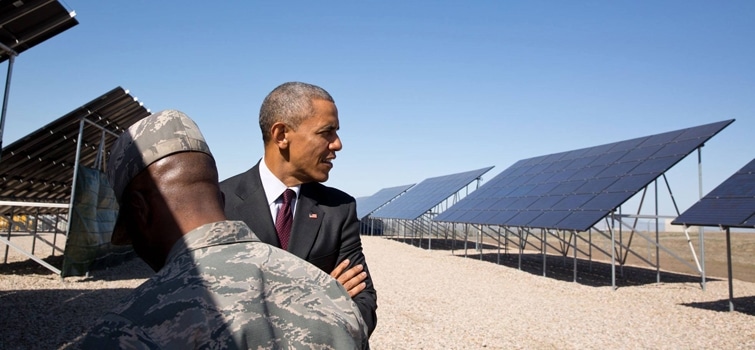As revealed in a memo leaked last week, President Trump has ordered Energy Secretary Rick Perry to use emergency powers to prop up failing coal and nuclear plants.
This is far from the first effort that this administration has made to bail out the nuclear and coal industries. It is doing its best to support its cronies, but it is failing. And the logic put forth by the administration to support the coal and nuclear industries have so far backfired.
The move drew condemnation from a wide assortment of environmental and pro-renewable energy groups, but also electrical industry stakeholders. You have to wonder: If we’re going to be protecting technology developed in the 1800s, what exactly is this administration going to push next?
I eagerly await the administration’s regulations protecting pagers, fax machines, and Blockbuster. https://t.co/ykLJHT4OvK
— Arnold (@Schwarzenegger) June 1, 2018
The real risk to the US electricity grid
The greatest piece of evidence – inadvertently – put forth by the Trump administration that solar and wind are ascendant, was the result of a study specifically hoping to attack the dependability of the U.S. power grid. The report, Staff Report to the Secretary on Electricity Markets and Reliability, was requested by DOE Secretary Perry as a result of lobbying by near-bankrupt coal executive Bob Murray, as demonstrated by a series of photos that led to the firing of whistleblower photographer Simon Edelman. The report was so critical to these efforts, that Energy Department staff leaked the report early, likely to protect it against political manipulation.

The result of this analysis was to show that the power grid’s stability was in fact increasing – even as wind and solar power raced to record volumes, and that the failure of coal and nuclear power was more due to competition with natural gas.
And when Federal Energy Regulatory Commission (FERC) reviewed the analysis as a result of political pressure from the DOE – it was shown that the biggest risk to the power grid was, in fact, from centralized electricity being dependent upon power lines.

Guess who else hates powerlines?
But beyond the Trump Administration’s pretense of concerns, there are parts of the federal government that have very real concerns about grid reliability. As revealed in a document put out by the Secretary of the Air Force, there is a legal requirement that Air Force bases in the United States:
Be able to power any infrastructure identified as critical to the performance of mission essential functions independent of the utility grid for the period of time needed to relocate the mission or for at least seven days, whichever is longer.
The Secretary of the U.S. Army has created a whole team – the Office of Energy Initiatives (OEI) – to help protect domestic bases against energy risk. The task of the OEI is to develop “islandable”� projects to provide the necessary energy and water resources to sustain critical missions for a minimum of 14 days in the event of a major disruption in supply.
Secretary of Defense, James “Mad-Dog” Mattis commenting on lessons learned in Iraq and Afghanistan, testified that the “military must be unleashed from the tether of fuel.” In military situations in Afghanistan and other nations, solar, wind and batteries have proven more stable sources of power.
The nuclear industry angle
In addition to the canard of grid reliability, the Trump Administration may use other rationales to prop up nuclear power. Less than two weeks ago U.S. Deputy Secretary of Energy Dan Brouillette claimed that nuclear-renewable systems could “link emission-free nuclear power plants with variable renewables like solar or wind farms and could allow nuclear power to backstop intermittent generation”.
This was made as the United States and partners launched a new push to develop small modular (nuclear) reactors (SMR). SMRs have no real operational track record to go on, so it isn’t clear that they could be used in such a fashion. While nuclear boosters have claimed that they are flexible, these advocates also claim that conventional nuclear power plants can be used in a flexible mode. This issue has been explored in detail by pv magazine, and we found that while nuclear power plants can ramp, that it is extremely impractical to do so both due to the wear on parts and the high capex/low opex nature of nuclear reactors.
But such a statement by DOE shows the reality of the situation. The U.S. government is not aiming to make nuclear power the new leader, but merely hoping to bring it back from death’s edge as a backup to the future. A future powered by the sun and the wind.
This content is protected by copyright and may not be reused. If you want to cooperate with us and would like to reuse some of our content, please contact: editors@pv-magazine.com.










Agreed. Let’s let the coal and nuclear industries die. We can figure out how to live off of only 17% of the power we normally use… and only during daylight….
As for air force bases. Is it easier to move generators around on a truck or install acres of solar modules that cost much more up front, aren’t portable, are easily targeted by a foreign enemy(god forbid)?
Hello Chris. I think you are forgetting natural gas, hydro, wind and other generation sources in your accounting. Also pretending that the share of renewables is static is frankly silly.
There is a reason why the U.S. military has preferred solar in remote locations, where they have to truck fuel in, and that is well documented. As for reliable supply in the United States, decentralized generation has the potential to be far more stable than centralized. See the recent failure of the Pilgrim nuke plant in Massachusetts in the middle of a massive snowstorm due to a downed line.
You would do well to do more research on these subjects before commenting.
Mattis disagrees with you.
Of course my comments are uninformed and lack research. I work “in” the industry and you write about it. Field level view VS 40,000ft view. I could do laps around you with conduit and you could edit my post like an English teacher, drawing red lines throughout and negative remarks throughout. It didn’t stop you from posting it, knowing you have obviously done more research, with the sole purpose of picking it apart and allowing your “crony”(lol) to pile on. I am reacting to yet another biased report from PV-Magazine. I find it amusing what you guys allow to be posted and not. Coal is not evil, otherwise please condemn the rest of the world for using it, including the solar panel manufactures who rely on coal to an extent in the production process. And remember, solar is massively propped up by federal incentives as well and, in it’s infancy, federal, state and local tax relief for purchases. So would solar be where it was without the ITC, CSI and local incentives that were prominent?
This article, like most articles here, makes very pertinent and valid arguments. But when it the argument has to be aimed at “everything else is bad” and (paraphrasing a sentiment, “President is wrong, always”) rather than look at the benefit of solar it just seems biased and, in cases where you mention the president, politically motivated.
Lastly in this ramble, don’t knock something for being old. Burning gas is old technology. The wheel is even older. Would you argue a stand alone point that the wheel should be retired because it’s old? You did that with fossil fuels.